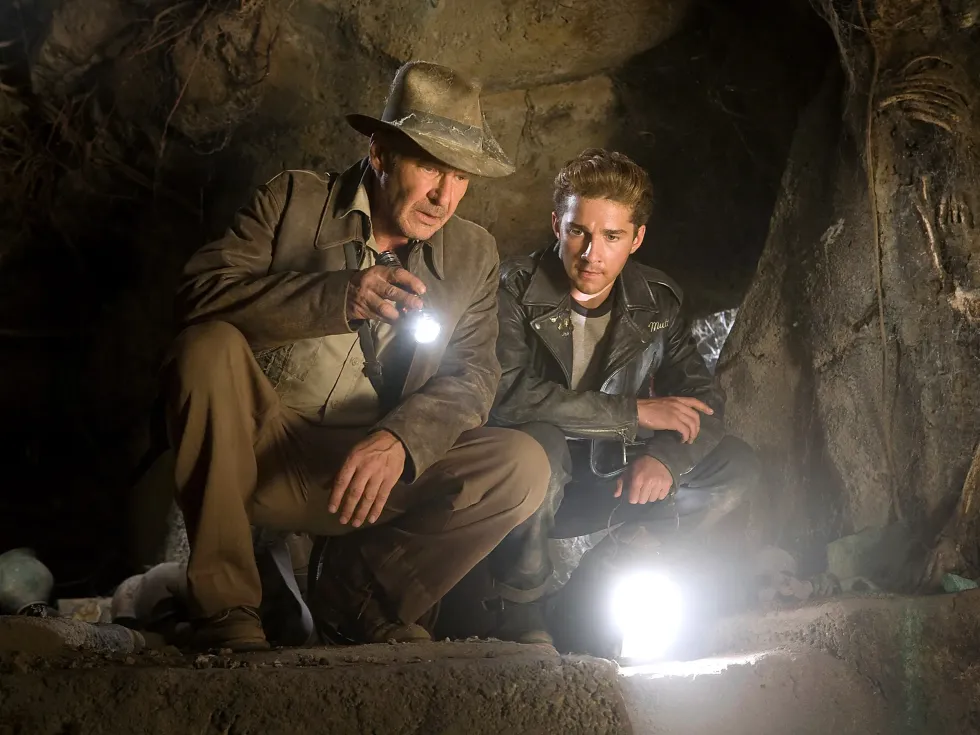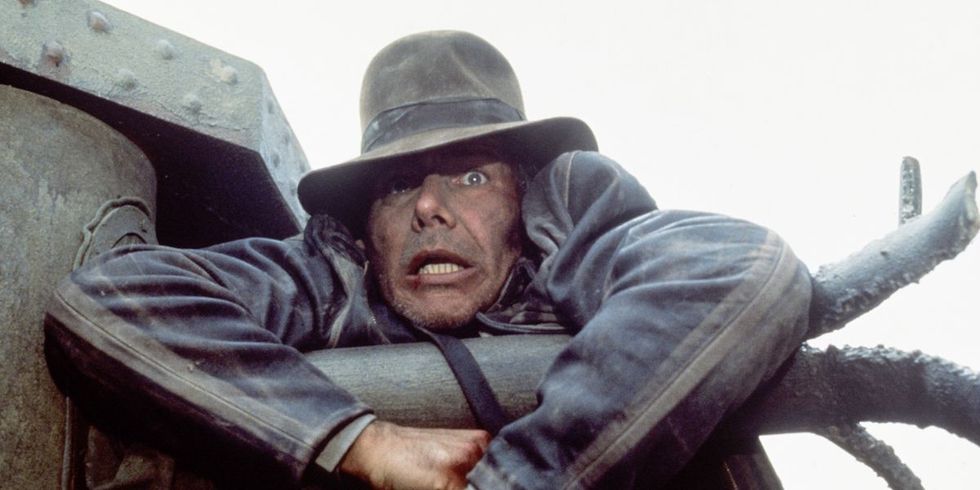
Who doesn’t love a good action movie? They have fun characters, great set pieces, and keep you on the edge of your seat for around two hours.
But they’re not easy to write or easy to brainstorm.
A great action spec has to stand out from the crowd and showcase your voice.
Crafting an enthralling action movie script is a tall order, requiring an intricate blend of dynamic conflict, high-stakes, and compelling characters. It’s not just about penning explosive car chases, intense shootouts, or nail-biting stunts; it’s also about immersing your audience in a fast-paced, edge-of-the-seat narrative that reveals character depth and advances the story.
This comprehensive guide explores the key elements to consider when venturing into action movie screenwriting. Let’s punch this out together.
10 Screenwriting Lessons From The ‘Indiana Jones’ Movies

The Indiana Jones franchise follows the fictional archaeologist and adventurer Dr. Henry “Indiana” Jones Jr. (Harrison Ford). The character and stories were created by George Lucas and directed by Steven Spielberg, the franchise has become one of the most popular and iconic in the history of cinema.
The first film in the series, Raiders of the Lost Ark, was released in 1981. Set in the 1930s, the movie introduces Indiana Jones as he embarks on a quest to find the Ark of the Covenant before it falls into the hands of Nazi Germany.
The success of Raiders led to four more films: Indiana Jones and the Temple of Doom (1984), Indiana Jones and the Last Crusade (1989), Indiana Jones and the Kingdom of the Crystal Skul” (2008), and Indiana Jones and the Dial of Destiny (2023). Each film follows Indiana Jones on a new adventure, battling villains, uncovering ancient artifacts, and navigating treacherous situations. The movies combine elements of archaeology, history, action, and humor, creating an exciting and entertaining blend.
So what can screenwriters glean from these epic tales?
1. The Most Active Protagonists Move the Story Along

Want a hero that keeps your story moving? Meet Indiana Jones, an archeologist who has something to do in every scene. An active protagonist is one who forges their path forward, propelling the story rather than letting the story drive them.
Indiana Jones is a great example of an active protagonist. He sets the story in motion by pursuing a MacGuffin. Whether that’s the ark of the covenant, missing holy stones, or the crystal skull, he is always making choices that propel the story forward. He’s rarely reactive, and never passive. His active involvement is a key ingredient for a captivating hero and an enthralling action movie.
2. Crafting an Interesting Hero

I think the idea of having a protagonist you “like” can feel outdated. I think it’s more important to be interesting, but Indiana Jones has all of this in spades. We fall in love with him as a person and we’re interested in his motivations and backstory, which gets revealed in each film in the series.
We learn to love Indy because he’s a leader who takes action in every scene, but he’s not perfect. Sometimes his actions lead him into deeper predicaments or cause larger problems. He’s also proficient. When we see Indiana cautiously avoiding light in the cave, casually brushing away spiders, or using his whip to swing across pits, we love him. We are drawn to people who excel at what they do.
We also love to watch as our hero risks his life for things he wants or to do what he thinks is right. Often, we see Indy thwarted by the villains. Whether they take his treasure or capture him, or just beat him up, he’s an underdog. If you want to create sympathy for a character, show them risking their life for something, only to have someone take it from them afterward. We will root for that character. We will want to see them succeed.
3. The Power of Action Sequences

An action set piece can make or break an adventure movie, and they are the lifeblood of Indiana Jones movies. Each movie has clever memorable moments, like running from the rock, getting your heart ripped out, a tank chase, swinging with monkeys, and fighting on the top of a train.
The action sequence begins with a clear objective, so we know exactly what your character needs. Then throw things at them to stop them. Think outside the box. If you’re writing an adventure, go big!
4. Reminding the Audience of the Challenge

A good screenplay amplifies the stakes by reminding the audience of the enormity and difficulty of the hero’s goal. For instance, in Raiders, there’s a scene where Indiana’s boss reminds him, “Nobody’s found the Ark in 3000 years. It’s like nothing you’ve gone after before.”
This reminder amplifies the stakes and reminds the audience of the magnitude of the task.
Let the audience in on the stakes of what happens if they don’t find an object or complete their task.
5. Breaking the Rules When Necessary

Part of being a great screenwriter involves recognizing when certain rules don’t apply to the specific story you’re telling. Each story is unique and requires unique choices.
For instance, one of the tenants of Joseph Campbell’s hero’s journey requires a “refusal of the call.” However, Indiana Jones never refuses the call. Because what we love about Indiana Jones is his fearlessness, manufacturing a “refusal of the call” moment would have felt forced and unnatural.
Always consider the possibility of discarding a rule if it doesn’t fit into your story. There are no real “rules” of screenwriting. Use your voice to tell us the best story.
6. A Memorable Introduction for Your Leads

One of the coolest parts of Indiana Jones is that we always have these fun character introductions. When we first meet Indy, he whips a gun out of someone’s hands and steps out of the shadows.
Marion’s (Karen Allen) introduction in Raiders, though not as dramatic as Indiana’s, is still quite powerful. We see her participating in a drinking competition followed by a battle with German/Nepalese thugs.
The way we meet your characters affects how we think about them. It’s your chance to make a real first impression on the audience. So put some thought into it.
7. Adding Urgency

Slow movies are fine, but if you’re writing and action adventure, you want the pacing of the story to move. You want to feel the excitement as characters follow maps and search for higher meaning.
The pace of Indiana Jones movies is quite impressive. Raiders achieves this pace not through dizzying editing tricks, but through solid story mechanics, specifically by adding urgency to the story whenever possible. Always look for opportunities to add urgency to your action movie.
Even the latest movie, Dial of Destiny, keeps its foot on the gas pedal of the Tuk-Tuk as it weaves new characters and stakes inside the story.
Your screenplay should have the forward propulsion, whether from an active character or just through quick dialogue and worldbuilding, always keep it moving.
8. Injecting Suspense into Conversations

Sometimes, Indiana Jones movies require a lot of exposition and conversation. Two-person dialogue scenes can quickly become boring, especially in an action film.
By adding an element of suspense to the conversation, you can keep the audience engaged.
For instance, in Raiders, while Indy and Marion are walking around Cairo, the scene keeps cutting to various bad guys preparing to attack them. This adds suspense to the conversation, making it more interesting than a straightforward dialog scene.
Even in the Tuk-Tuk scene in Dial of Destiny, we are understanding the complex relationship between Indy and his goddaughter, while also escaping villains.
9. Moving on from Death in an Action Movie

A lot of people die in Indiana Jones movies. One of the most touching I think is when his buddy dies at the start of Temple of Doom. But Indy also kills a lot of Nazis. Which is awesome.
Death in these movies can be slowed down for emotional effect or sped up for anonymous villains.
When a major character dies in your movie, you need to make the audience believe that your hero is willing to continue his journey. The formula to solve this problem involves a quick scene of mourning, followed by the hero placed in a dangerous situation.
This allows the audience to forget about the death and refocus on the story.
10. Everything Comes Down to Character Development

As I said at the top, Indiana Jones is one of the greatest characters ever crafted. In every movie, we touch in on who Indy is and how the story brings out something new in him. In the first movie, he’s a guy who doesn’t believe in spirituality, confronting the ark of the covenant.
In Temple of Doom, he’s a loner working with a team, dealing with the people who rely on him to succeed. In the final movie, he’s an old man who has seen it all, dealing with the weight of that journey.
In every movie, we get a deep character and a set of side characters who all have specific wants and desires. This specificity is what makes them all feel real and actualized. And what makes the audience come back for more and more.
Summing Up 10 Screenwriting Lessons From The Indiana Jones Movies
The Indiana Jones series offers a treasure trove of screenwriting lessons.
By analyzing the series, we can learn the importance of active protagonists, crafting likable heroes, constructing action sequences, reminding the audience of the challenge, breaking rules when necessary, creating memorable introductions for leads, adding urgency, injecting suspense into conversations, moving on from death in an action movie, and character development. To create an engaging and memorable screenplay, keep these lessons in mind.
Now it’s your turn to go get writing and create the next amazing franchise of feature screenplays.
Author: Jason Hellerman
This article comes from No Film School and can be read on the original site.
